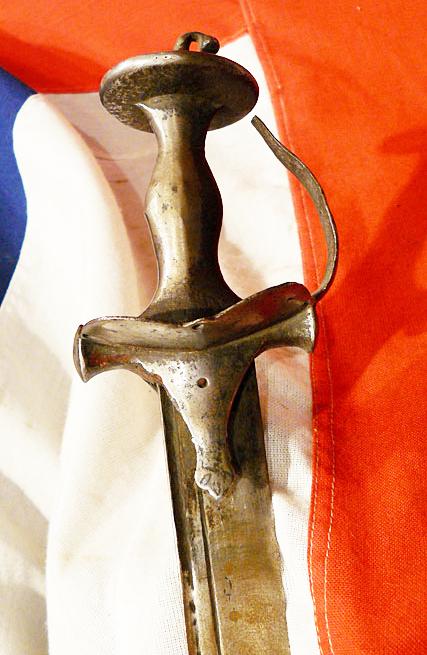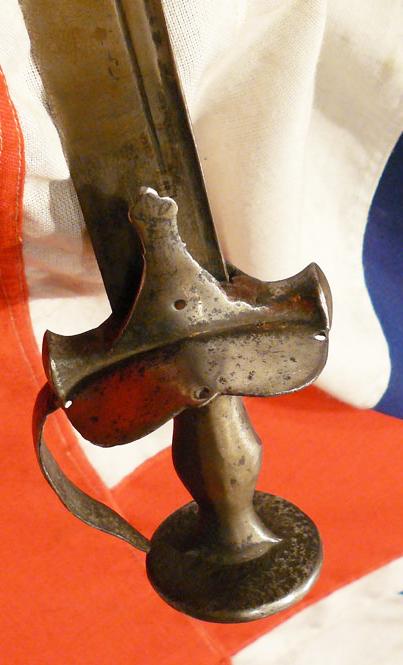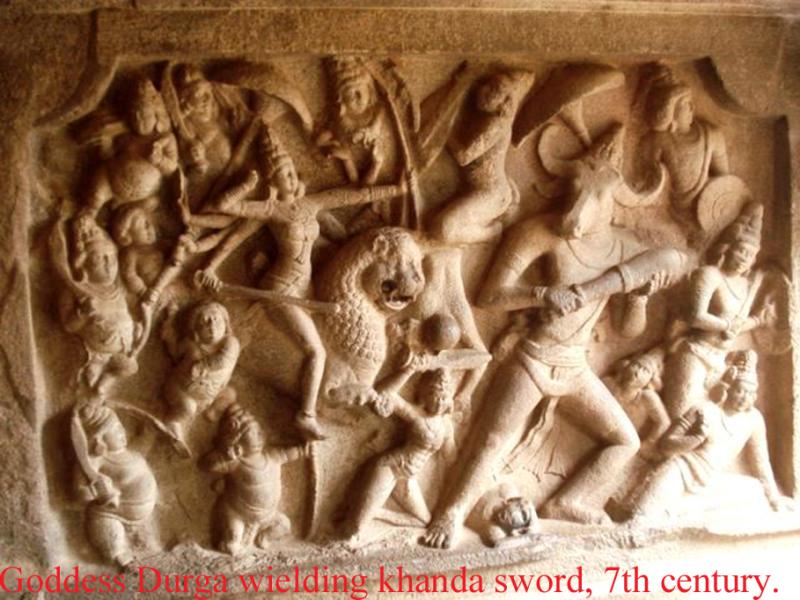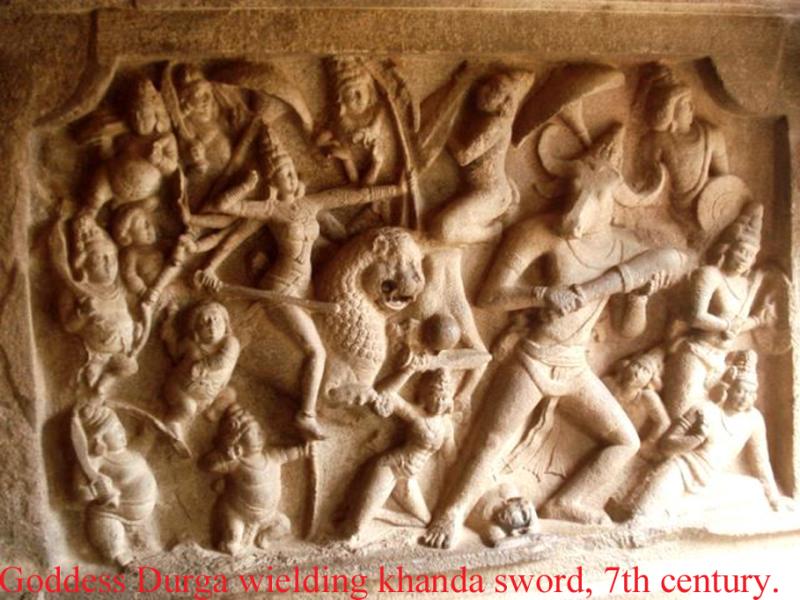A Beautiful Early Sikh Khanda Hilt Firangi Sword 17th to 18th Century
Long double fuller straight firangi blade, single knuckle bow and double plate guard. overall in nice condition for age. Early swords appear in the archaeological record of ritual copper swords in Fatehgarh Northern India and Kallur in Southern India. Although the Puranas and Vedas give an even older date to the sacrificial knife. Straight swords, (as well as other swords curved both inward and outward), have been used in Indian history since the Iron Age Mahajanapadas (roughly 600 to 300 BC), being mentioned in the Sanskrit epics, and used in soldiers in armies such as those of the Mauryan Empire. Several sculptures from the Gupta era (AD 280-550) portray soldiers holding khanda-like broadswords. These are again flared out at the tip. They continued to be used in art such as Chola-era murtis.
There is host of paintings depicting the khanda being worn by Rajput kings throughout the medieval era. It was used usually by foot-soldiers and by nobles who were unhorsed in battle. The Rajput warrior clans venerated the khanda as a weapon of great prestige.
Goddess Durga wielding khanda sword, 7th century.
According to some, the design was improved by the Great Rajput Emperor Prithviraj Chauhan. He added a back spine on the blade to add more strength. He also made the blade wider and flatter, making it a formidable cutting weapon. It also gave a good advantage to infantry over light cavalry enemy armies.
Rajput warriors in battle wielded the khanda with both hands and swung it over their head when surrounded and outnumbered by the enemy. It was in this manner that they traditionally committed an honourable last stand rather than be captured. Even today they venerate the khanda on the occasion of Dasara.
Maharana Pratap is known to have wielded a khanda. The son in law of Miyan Tansen, Naubat Khan also wielded khanda and the family was known as Khandara Beenkar. Wazir Khan Khandara was a famous beenkar of 19th century.
Many Sikh warriors of the Akali-Nihang order are known to have wielded khandas. For instance, Baba Deep Singh is famous for wielding a khanda in his final battle before reaching his death, which is still preserved at Akaal Takhat Sahib. Akali Phula Singh is also known to have wielded a khanda, and this practise was popular among officers and leaders in the Sikh Khalsa Army as well as by Sikh sardars of the Misls and of the Sikh Empire. The Sikh martial art, Gatka also uses khandas.
Hari Singh Nalwa was the commander-in-chief of the Sikh Empire (Sarkar Khalsa) under Maharaja Ranjit Singh. The Times of London wrote an article in 1881 where they not only noted his battlefield prowess but also his success as an administrator and foresight. The article went onto state that "had he had the money and resources of available to European states, it would have been entirely possible that he could have reached the border of Europe."
Despite reaching lofty heights, Hari Singh Nalwa had humble beginnings. Born in 1791 as Hari Singh Uppal, the youngster, like so many others on this list, lost his father at an early age. In 1804 his mother sent him to the court of Maharaja Ranjit Singh to resolve a property dispute. While there Hari Singh explained that his father and grandfather had both fought under Ranjit Singh's Sukerchak Misl for both his father Maha Singh and his grandfather Charat Singh. The Maharaja decided the arbitration in Hari Singh's favour and impressed by his skill as a musketeer gave him a job as a personal attendant. Hari Singh's climb to fame began later that year during a hunt where his party was attacked by a tiger. In one of the most famous stories in Sikh history, Hari Singh killed the tiger by ripping it apart using his hands, this earned him the nickname Baagh Maar, or Tiger Killer. As his reputation grew from the story, he was commissioned as a Sardar and given 800 horses and footmen under his command.
Hari Singh led his first independant contingent into battle in 1807 at Kasur under the leadership of the Maharaja, Jodh Singh Ramgharia and Akali Phula Singh Nihang. Hari Singh's performance was rewarded by a jagir (land based revenue) and his fame continued to grow. A year later Hari Singh led his first command of an army at the Battle of Sialkot where the 17 year old defeated Jiwan Singh.
The young Hari Singh fought numerous battles over the coming years in Attock, Kashmir and Mahmudkot. During the Battle of Multan in 1818, Hari Singh Nalwa led a division of Sikhs against Muzzaffar Khan. The Muslim ruler put up one of the strongest fights the Sikhs had encountered and although instrumental in the victory, Hari Singh Nalwa was badly burnt from a firepot thrown from the fort, putting him out of action for a number of months. However, he was fully recovered by 1819 to lead the reaguard of the Sikh conquest of Kashmir. The victory ended 5 centuries of Muslim rule and the cities of Lahore and Amritsar were lit up in celebration for three nights.
The conquest of Kashmir ushered in a decade of rapid Sikh conquest, and Hari Singh Nalwa was involved in or led most of the major battles. The 1827 Battle of Saidu was one of the most comprehensive. Sayed Bareli had proclaimed himelf to be a messenger of the Prophet Muhammed tellling all his tribesmen that he would deliver the Muslims from Sikh rule As local Muslim rulers began to heed his call, he eventually managed to command an army of over 15,000 Muslims, ready to raise Jihad against the Sikhs. On 23 February, the Sikhs under Hari Singh and Budh Singh Sandhanwalia met the self proclaimed messenger in battle and routed his army. They then pursued the enemy for 6 miles, plundering and pillaging as they went. By 1834 the Sikhs occupied Peshawar. At this point Hari Singh's reputation had become so widespread that Afghan women used to scare their children to sleep by mentioning that if they stayed awake "Hari Singh and his Sikhs would get them".
31.5 inch blade
Code: 24207
445.00 GBP





